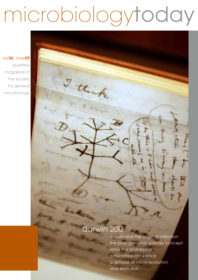Darwin 200
11 May 2009 publication
The lead articles of the May 2009 issue of Microbiology Today are on Darwin and the origin of infection; the phylogenomic species concept; retire the prokaryote; a microbial cockatrice; a glimpse of micro-evolution; and virus evolution.
Darwin: from the origin of the species to the origin of infection - Mark Pallen
What did Charles Darwin himself know about micro-organisms? He lived through the birth of the discipline and Mark Pallen explores some links between Darwin and the founding fathers of microbiology.
The phylogenomic species concept - Jim Staley
Classifying microbes has always been difficult because they are constantly evolving and changing, but nevertheless they have an accepted place on the tree of life. Although modern molecular techniques are of great help to microbial taxonomists, 16S rRNA gene sequencing has limitations when it comes to differentiating between species of bacteria. Jim Staley proposes an alternative approach – the phylogenomic species concept.
It’s time retire the prokaryote - Norman Pace
What is a prokaryote? Does anyone really know? Norman Pace thinks not, and believes that the term has stuck since it was first coined in the late 19th century, but with no scientific foundation. He would like all microbiologists to join him in scrapping this anachronism in modern biology.
Archaea: a microbial cockatrice - Ed Bolt and Stephane Delmas
A cockatrice was a flamboyant sight at medieval banquets, featuring a roasted chimera of rooster fused to a suckling pig. Ed Bolt and Stephane Delmas think that there are similarities with archaea, ancient micro-organisms that have features of both bacteria and eukaryotes within their genomes.
A glimpse of microevolution in nature: bacterial adaptation and speciation in ‘Evolution Canyon’, Israel - Johannes Sikorski
Some canyons in Israel have north- and south-facing slopes that have completely different environments, despite their close proximity. Johannes Sikorski has been looking at the micro-organisms that live in these habitats and come to some surprising conclusions that might help us understand micro-evolution rather better.
Virus evolution - Peter Simmonds
New mass sequencing techniques are revealing that the diversity of viruses is much greater than ever imagined. Peter Simmonds shows that some recent ‘new’ viruses are providing clues to how viruses evolve.
Comment: An April diary - Robin Weiss
SGM President Robin Weiss has been globe-trotting in April. His visits included the SGM meeting at Harrogate where Nobel prize-winner Stan Prusiner received an award from the Society and described his latest researches into prions, attendance at various conferences to discuss the latest findings into HIV/AIDS and the launch of a new European Society for Virology. In the course of his busy schedule, swine ‘flu emerged in Mexico and began to spread around the world, taxing the skills of microbiologists.
Schoolzone
Hand hygiene is vital in stopping the spread of infectious diseases such as colds and ‘flu, and SGM was at a science fair recently to bring the message home to hundreds of schoolkids about what happens when they come into contact with viruses and don’t wash their hands! Antimicrobial resistance also gets an airing in this feature, when Dariel Burdass describes how it occurs and how it links in to Darwin 200. Plus there is news of some new teaching resources.
Gradline
Jane Westwell takes a more oblique look at career development and describes how ‘planned happenstance’ can actually lead to the road to success. She also covers the Myers-Briggs Type Indicator as a novel way of improving performance at work.
Going Public
Raising the profile of microbiology in schools is important and at Nottingham Trent University, the staff of the School of Science and Technology have developed a programme of activities that is going down very well. Using art as a medium to improve the understanding of microbiology is a very different approach, but it works, as Mike Wilson shows in his article about The Wellcome window display. This demonstrates the distribution of bacteria on a healthy human body using petri dish cultures.



